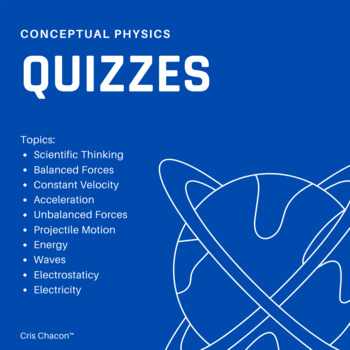01 - Scientific Thinking Quiz 2
Conceptual Physics
172 Followers
Grade Levels
7th - 12th
Subjects
Resource Type
Standards
CCSS8.F.A.3
CCSS8.F.B.4
CCSS8.F.B.5
CCSSHSN-Q.A.1
CCSSHSN-Q.A.2
Formats Included
- Google Docs™
Pages
1 page
Conceptual Physics
172 Followers

Made for Google Drive™
This resource can be used by students on Google Drive or Google Classroom. To access this resource, you’ll need to allow TPT to add it to your Google Drive. See our FAQ and Privacy Policy for more information.
Also included in
- 21 fully editable, NGSS/modeling pedagogy aligned quizzes! There are a mix of free response and multiple choice questions for most quizzes, which are usually one or two pages long. Quizzes are used for students to demonstrate proficiency of learning targets outlined in the corresponding curriculum gPrice $100.00Original Price $128.00Save $28.00
- 21 fully editable, NGSS/modeling pedagogy aligned quizzes, 9 unit tests, 10 writing assignments, and 2 final exams!QuizzesThere are a mix of free-response and multiple-choice questions for most quizzes, which are usually one or two pages long. Quizzes are used for students to demonstrate proficiencyPrice $225.00Original Price $268.00Save $43.00
- *You can request sample previews of resources or units! Please email cris.chacon@knowlesteachers.org to request them. Additionally, upon purchase, please email cris.chacon@knowlesteachers.org to receive immediate access to all of these resources and more through Google Drive Folders and Documents.43Price $675.00Original Price $841.00Save $166.00
- 3 fully editable, NGSS/modeling pedagogy aligned worksheets, 4 inquiry labs, 3 lab challenges, 2 quizzes, 6 guided notes/reading assignments, 1 unit review, 1 writing assignment, 1 equation toolbox, and 1 curriculum guide!WorksheetsThere are a variety of free response questions for most worksheets,Price $60.00Original Price $76.00Save $16.00
- 17 fully editable, NGSS/modeling pedagogy aligned worksheets, 9 quizzes, 16 inquiry labs, 4 unit reviews, 4 unit tests, 7 lab challenges, 5 writing assignments, 5 concept builders, 5 equation toolboxes, 15 guided readings and notes, and 5 curriculum guides!WorksheetsThere are a variety of free respoPrice $350.00Original Price $427.00Save $77.00
Description
Fully editable, NGSS/modeling pedagogy aligned quiz! There is a mix of free-response and multiple-choice questions for most quizzes, which are usually one or two pages long. Quizzes are used for students to demonstrate proficiency of learning targets outlined in the corresponding curriculum guide by deployIng models developed from inquiry labs and utilized in problem-solving on worksheets. Quizzes are a good way for students to gauge their level of mastery to indicate how to study for unit tests.
Learning Targets Assessed:
I know...
- whether an object will float or sink using the substance and object density.
I can...
- determine the mass, volume, or density of an object with enough information.
- identify an unknown material based on its density.
Solutions are available by purchasing the Conceptual Physics Quiz Bundle.
Total Pages
1 page
Answer Key
Included
Teaching Duration
N/A
Report this resource to TPT
Reported resources will be reviewed by our team. Report this resource to let us know if this resource violates TPT’s content guidelines.
Standards
to see state-specific standards (only available in the US).
CCSS8.F.A.3
Interpret the equation 𝘺 = 𝘮𝘹 + 𝘣 as defining a linear function, whose graph is a straight line; give examples of functions that are not linear. For example, the function 𝘈 = 𝑠² giving the area of a square as a function of its side length is not linear because its graph contains the points (1,1), (2,4) and (3,9), which are not on a straight line.
CCSS8.F.B.4
Construct a function to model a linear relationship between two quantities. Determine the rate of change and initial value of the function from a description of a relationship or from two (𝘹, 𝘺) values, including reading these from a table or from a graph. Interpret the rate of change and initial value of a linear function in terms of the situation it models, and in terms of its graph or a table of values.
CCSS8.F.B.5
Describe qualitatively the functional relationship between two quantities by analyzing a graph (e.g., where the function is increasing or decreasing, linear or nonlinear). Sketch a graph that exhibits the qualitative features of a function that has been described verbally.
CCSSHSN-Q.A.1
Use units as a way to understand problems and to guide the solution of multi-step problems; choose and interpret units consistently in formulas; choose and interpret the scale and the origin in graphs and data displays.
CCSSHSN-Q.A.2
Define appropriate quantities for the purpose of descriptive modeling.







